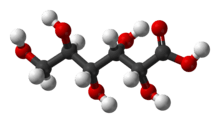Gluconic acid
Gluconic acid is an organic compound with molecular formula C6H12O7 and condensed structural formula HOCH2(CHOH)4COOH. It is one of the 16 stereoisomers of 2,3,4,5,6-pentahydroxyhexanoic acid.
 | |
 | |
| Names | |
|---|---|
| IUPAC name
d-Gluconic acid | |
| Systematic IUPAC name
(2R,3S,4R,5R)-2,3,4,5,6-Pentahydroxyhexanoic acid | |
| Other names
Dextronic acid | |
| Identifiers | |
CAS Number |
|
3D model (JSmol) |
|
| ChEBI | |
| ChEMBL | |
| ChemSpider | |
| ECHA InfoCard | 100.007.639 |
| EC Number |
|
| E number | E574 (acidity regulators, ...) |
PubChem CID |
|
CompTox Dashboard (EPA) |
|
InChI
| |
SMILES
| |
| Properties | |
Chemical formula |
C6H12O7 |
| Molar mass | 196.155 g·mol−1 |
| Appearance | Colorless crystals |
| Melting point | 131 °C (268 °F; 404 K) |
Solubility in water |
316 g/L[1] |
| Acidity (pKa) | 3.86[2] |
Except where otherwise noted, data are given for materials in their standard state (at 25 °C [77 °F], 100 kPa). | |
| Infobox references | |
In aqueous solution at neutral pH, gluconic acid forms the gluconate ion. The salts of gluconic acid are known as "gluconates". Gluconic acid, gluconate salts, and gluconate esters occur widely in nature because such species arise from the oxidation of glucose. Some drugs are injected in the form of gluconates.
Chemical structure
The chemical structure of gluconic acid consists of a six-carbon chain, with five hydroxyl groups positioned in the same way as in the open chained form of glucose, terminating in a carboxylic acid group. In aqueous solution, gluconic acid exists in equilibrium with the cyclic ester glucono delta-lactone.
Occurrence and uses
Gluconic acid occurs naturally in fruit, honey, and wine. In 1929 Horace Terhune Herrick developed a process for producing the salt by fermentation.[3] As a food additive (E574[4]), it is now known as an acidity regulator.
The gluconate anion chelates Ca2+, Fe2+, Al3+, and other metals, including lanthanides and actinides. It is also used in cleaning products, where it dissolves mineral deposits, especially in alkaline solution.
Calcium gluconate, in the form of a gel, is used to treat burns from hydrofluoric acid;[5][6] calcium gluconate injections may be used for more severe cases to avoid necrosis of deep tissues, as well as to treat hypocalcemia in hospitalized patients. Gluconate is also an electrolyte present in certain solutions, such as "plasmalyte a", used for intravenous fluid resuscitation.[7] Quinine gluconate is a salt of gluconic acid and quinine, which is used for intramuscular injection in the treatment of malaria.
Zinc gluconate injections are used to neuter male dogs.[8]
Ferrous gluconate injections have been proposed in the past to treat anemia.[9]
Gluconate is used as a concrete admixture (retarder) to slow down the cement hydration reactions and to delay the cement setting time. It allows so a longer time to place the concrete or to spread the cement hydration heat on a longer period of time to avoid too high temperature and the resulting cracks.[10][11] Retarders are mixed to concrete when the weather temperature is high or to cast large and thick concrete slabs in successive and sufficiently well mixed layers.
See also
- Uronic acid
- Glucuronic acid
- Isosaccharinic acid (ISA)
References
- "D-Gluconic acid". American Chemical Society.
- Bjerrum, J., et al. Stability Constants, Chemical Society, London, 1958.
- "All Chemistry". Time magazine. May 13, 1929. Retrieved 2010-07-12.
Dr. Horace T. Herrick (U. S. Department of Agriculture) told of experiments aiming to produce tartaric acid from mold. They did not succeed in their aim, but a way was found of procuring gluconic acid. This acid formerly cost $100 per lb., can now be made for less than 35¢. It can be used in dyestuff manufacture at the new price; also, to make calcium gluconate, valuable medicinally in the treatment of hemorrhages.
- Current EU approved additives and their E Numbers. Food Standards Agency.
- el Saadi M. S., Hall A. H., Hall P. K., Riggs B. S., Augenstein W. L., Rumack B. H. (1989). "Hydrofluoric acid dermal exposure". Vet Hum Toxicol. 31 (3): 243–7. PMID 2741315.CS1 maint: uses authors parameter (link)
- Roblin I., Urban M., Flicoteau D., Martin C., Pradeau D. (2006). "Topical treatment of experimental hydrofluoric acid skin burns by 2.5% calcium gluconate". J Burn Care Res. 27 (6): 889–94. doi:10.1097/01.BCR.0000245767.54278.09. PMID 17091088.CS1 maint: uses authors parameter (link)
- D. Thomas, U. Jaeger, I. Sagoschen, C. Lamberti and K. Wilhelm (2009), Intra-Arterial Calcium Gluconate Treatment After Hydrofluoric Acid Burn of the Hand. CardioVascular and Interventional Radiology, Volume 32, Number 1, pages 155–158, doi:10.1007/s00270-008-9361-1
- Julie K. Levy, P. Cynda Crawford, Leslie D. Appel, Emma L. Clifford (2008), Comparison of intratesticular injection of zinc gluconate versus surgical castration to sterilize male dogs. American Journal of Veterinary Research Vol. 69, No. 1, Pages 140–143. doi:10.2460/ajvr.69.1.140
- Paul Reznikoff and Walther F. Goebel (1937), The preparation of ferrous gluconate and its use in the treatment of hypochromic anelia in rats. Journal of Pharmacology and Experimental Therapy, volume 59 issue 2, page 182.
- Ramachandran, V.S.; Lowery, M.S. (1992). "Conduction calorimetric investigation of the effect of retarders on the hydration of Portland cement". Thermochimica Acta. 195: 373–387. doi:10.1016/0040-6031(92)80081-7. ISSN 0040-6031.
- Ma, Suhua; Li, Weifeng; Zhang, Shenbiao; Ge, Dashun; Yu, Jin; Shen, Xiaodong (2015). "Influence of sodium gluconate on the performance and hydration of Portland cement". Construction and Building Materials. 91: 138–144. doi:10.1016/j.conbuildmat.2015.05.068. ISSN 0950-0618.